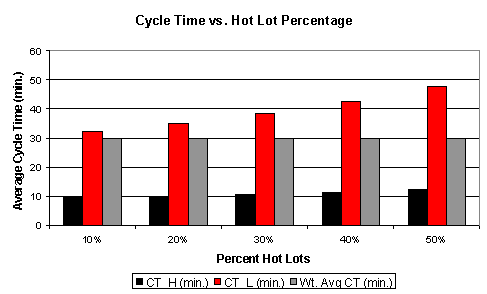Consider a single workstation with two classes of lots, one receiving high priority, the other receiving low priority. Suppose that the workstation contains only a single machine. The dispatch rule is non-preemptive head-of-the-line, in that high priority lots that arrive during the service of a low priority lot do not interrupt service. Rather, the high priority lot moves ahead of any low priority lots waiting for service. Within a priority class, service is FIFO. Let λH, λL denote the arrival rates for the two classes. Let μH, μL denote the service rates for the two classes. Denote the traffic intensities by ρH = λH/μH, ρL = λL/μL and assume ρH + ρL < 1. We obtain the limiting expected queuing delay from Table 4.4 of Prabhu (1981), and after adding the expected service time, we find the expected time in system for high priority lots to be
- ν (1 - ρH)-1 + μH-1,
- and for the low priority lots to be
- ν ((1 - ρH)(1 - ρH - ρL))-1 + μL-1,
- where
- ν = λL μL-2 + λH μH-2.
- Suppose λH = 1 lot/hour, λL= 9 lots/hour, μH = 12.0 lots/hour = μL
- Then ν = 0.06944, and the expected time in system for high priority lots is
- [ .06944 / (1 - .0833)] + [1/12] = .0758 + .08333 = .15909 hours = 9.545 min.
- For low priority lots, the expected time in system is
- [ .06944 / (1 - .0833)(1 - .0833 - .75)] + [1/12] = .4545 + .0833 = .5379 hours = 32.27 min.
As we increase the percentage of high priority lots, the expected time in system (or cycle time) of the low priority lots increases rapidly, and non-linearly, although the weighted average cycle time remains the same (30 minutes in this example). This is shown in the figure below.
